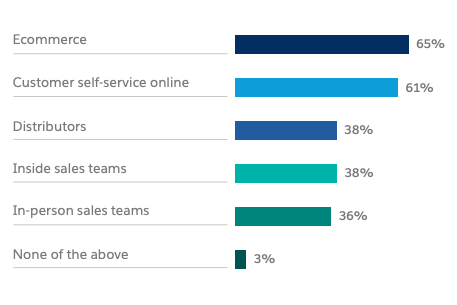Business-to-business (B2B) organisations have undergone a massive transformation in the face of lockdown measures. But it’s not just large B2B organisations that have had to adapt to changes brought on by the global pandemic. Small teams and B2B players have had to acclimate to a shifting landscape as well.
Seemingly overnight, B2B teams had to scrap in-person meetings and adapt to remote working. Dealing with the effects of multiple global crises and increasing demand for different skill sets created an initial setback.
In this new normal, communication over digital channels became the status quo. B2B reps took on new and more expanded roles as buyers began to look at them as trusted advisors who could help navigate the chaos. On top of all this, a new wave of digital consumers led to sky-high expectations. Online shoppers began demanding an ‘Amazon-like’ experience from their vendors.
A transformative time for B2B organisations
Traditionally, B2B organisations lagged behind their B2C counterparts in the digital arms race. But after the global pandemic, everything changed. It’s been a time of massive ‘people transformation’ and a period of wholesale digital transformation as well.
To better understand the current state of commerce, we conducted a global survey to learn how businesses are tackling the challenges of today and preparing for the future. We surveyed nearly 1,400 commerce leaders and analysed the behaviour of more than 1 billion consumers and buyers from around the globe to discover:
Shifts in consumer (B2C) and business (B2B) buying
How digital commerce has changed the role of sales
The effects of the pandemic on consumer behavior
How B2B commerce is evolving
The results have been published in this handy infographic summarising the main points:
Let’s take a look at what the findings can tell us about the state of B2B commerce today.
B2B organisations are warming up to ecommerce
B2B organisations are increasingly turning to ecommerce to better meet the needs of their buyers. The report reveals that 83% of B2B players are now selling online. Moreover, the period between January and August saw a 44% rise in online orders. This shift to digital has raised the bar for customer experience.
Business buyers and competitors are moving forward to embrace the new normal. So B2B organisations that aren’t online or haven’t optimised their ecommerce channel will be left behind.
Another telling statistic from the report is that nearly 33% of B2B organisations say that 50% or more of their revenue is already coming from digital channels. And 55% say that this will be the case within the next three years.
In fact, ecommerce is the top investment priority for B2B organisations over the next two years. This highlights just how important digital channels are becoming for remaining relevant and competitive.
Digital transformation is inevitable for B2B organisations
The shift towards ecommerce is enabling B2B reps to focus on better serving their buyers, rather than spending their time on transactional, low-value tasks. According to our report, 63% of B2B organisations say that ecommerce has freed reps from order processing. This empowers them to act as strategic advisors; an increasingly important aspect of doing business in the new normal.
“21% (of B2B organisations) report that digital commerce allows sales teams to focus more time and attention on their most valuable customers.”
The demands of the new climate are twofold as the current landscape requires B2B players to increase their arsenal of digital technologies. It also requires more value-added personal contact.
Personalised service has become critical, as customers want B2B reps that:
are empathetic,
have highly developed soft skills,
understand their unique needs and pain points.
It’s no surprise then that B2B leaders are using the new revenue streams from ecommerce to increase investment in their in-person sales teams. Considering, over half (52%) of high-performing B2B organisations report plans to increase investment in their in-person sales teams over the next two years.
B2B organisations break silos and integrate service teams into commerce
Customer service teams have also been empowered by the shift to digital, In fact, 57% of B2B organisations report that their service teams are now more involved in overall commerce experiences. This cross-functional collaboration highlights another concern of B2B organisations in the current climate: breaking silos.
Our report reveals that high performers are especially proactive about connecting departments and functions to provide a smoother overall customer experience across all touchpoints. This focus on crafting exceptional customer journeys will have a trickle-down effect to create significant differentiation for businesses that adopt an omnichannel approach. And those that don’t will suffer by comparison.
Turbocharge B2B digital growth to face the future
It’s clear that the future of B2B commerce is a digital one. But how can B2B players accelerate their digital roadmap to better prepare for a quickly approaching future?
Here are a few tips for driving B2B digital growth:
Prioritise resilience and flexibility. These are increasingly prized traits that can help B2B organisations navigate change. On-demand training platforms like Trailhead can help reskill and upskill the workforce to prepare for the future.
Keep up with your customers. Leveraging data to make smarter decisions and personalise communications is a great way to get to know your audience, better understand their needs, and offer them value-added experiences across each touchpoint.
Create seamless experiences. Connecting touchpoints is a good place to start, but also consider implementing self-service capabilities, like quick reordering and AI-driven chatbots.
Break silos between departments. Provide the right data and tools to enable cross-functional collaboration. This not only helps build a more agile workforce but also creates a better buyer experience.
What’s next for B2B organisations?
B2B has changed quite a bit in the wake of the pandemic, but much of that change has been positive. Today’s B2B organisations have more tools than ever at their disposal. They can be highly connected, versatile, in tune with their buyers, and ready to face the challenges of tomorrow.
Companies that manage to capture market share in times of crisis (by staying agile in combination with a customer-centric approach) are more likely to capture a significant first-mover advantage and emerge even stronger in the next normal, according to recent research. With that in mind, this is the best time for B2B organisations to take advantage of this incredible momentum and start their digital transformation.
To see more about how today’s B2B organisations are tackling challenges and growing stronger, check out the entire State of Commerce report.






